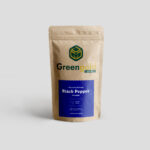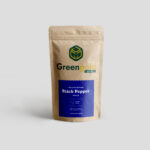When it comes to cooking, pepper is one of the most common and beloved spices in the world. But if you’ve ever stood in the spice aisle wondering whether to grab black pepper or white pepper, you’re not alone. While they come from the same plant (Piper nigrum), these two types of peppercorns have distinct flavors, different processing methods, and unique culinary uses.
In this guide, we’ll break down everything you need to know about the difference between white pepper and black pepper, so you can use them like a pro in your kitchen! 🍽️
👉 Shop premium pepper varieties at Greengold Guide!
1. What Is Black Pepper? 🌿
Black pepper is the most widely used spice globally, often called the “king of spices.” It comes from the unripe green berries of the pepper plant.
How It’s Made:
- The berries are harvested while still green and unripe.
- They are then boiled briefly and sun-dried.
- During drying, the skin shrinks and darkens, forming the familiar black, wrinkled exterior.
Flavor Profile:
- Pungent, spicy, and earthy.
- Provides a sharp bite and warmth to dishes.
Best Uses:
- Seasoning meats, vegetables, soups, salads, and just about any savory dish.
- Black pepper works well as a universal seasoning.
2. What Is White Pepper? 🧄
White pepper comes from the same plant but is processed differently, leading to a milder and more subtle flavor.
How It’s Made:
- The berries are allowed to fully ripen on the vine until they turn red.
- They are then soaked in water to ferment for several days.
- After fermentation, the outer skin is removed, leaving just the inner seed, which is dried to produce white pepper.
Flavor Profile:
- Milder, earthy, and slightly musty or fermented in taste.
- Lacks the outer layer’s pungency, offering a smoother heat.
Best Uses:
- Light-colored dishes like white sauces, cream soups, and mashed potatoes where you don’t want the black specks of black pepper.
- Popular in Asian cuisines, especially Chinese and Thai cooking.
3. Key Differences Between White Pepper and Black Pepper ⚡
| Feature | Black Pepper | White Pepper |
|---|---|---|
| Color | Dark brown/black | Pale beige/white |
| Flavor | Bold, pungent, spicy | Mild, earthy, slightly fermented |
| Processing | Dried with skin on | Skin removed after fermentation |
| Uses | Everyday seasoning for almost any dish | Light-colored dishes, delicate flavors |
| Heat Level | Strong, immediate heat | Softer, lingering heat |
| Appearance in Food | Visible black specks | Blends in seamlessly |
4. Which One Should You Use? 🍳
Both peppers have their place in the kitchen, and the choice depends on the dish and your taste preference:
- Use Black Pepper when you want bold flavor and don’t mind seeing the pepper.
- Use White Pepper when you want the pepper’s heat without changing the color or when working with delicate flavors.
If you’re making alfredo sauce, creamy soups, or potato dishes, white pepper is your best friend. For steaks, roasted veggies, and hearty soups, black pepper reigns supreme.
5. Fun Fact: Nutrition and Health Benefits 🌿
Both black and white pepper are rich in piperine, the compound that offers:
- Anti-inflammatory properties
- Improved digestion
- Enhanced nutrient absorption
- Antioxidant support
Whether black or white, freshly ground pepper gives you the best health benefits! 💪
👉 Learn more about the health benefits of black pepper here.
6. Final Thoughts: Choose Wisely, Spice Boldly 🌶️
Black pepper and white pepper may come from the same plant, but their differences in flavor and appearance mean they each shine in their own way. Having both on hand gives you the versatility to season like a master chef and bring out the best in your meals.
Next time you cook, think about what flavor you want to achieve — bold and earthy or smooth and subtle — and choose your pepper wisely! 🧂✨
👉 Stock your spice rack with premium black and white pepper from Greengold Guide!


